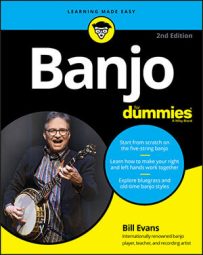Although Scruggs style uses right-hand roll patterns as the basic building blocks of banjo technique, melodic banjo is based on finding and playing scales up and down the neck.
Assigning numbers to the notes in the G-major scale
You could locate all the notes for the G-major scale on the first five frets of the banjo. But here, instead of labeling the notes with the syllables “do-re-mi” as the Von Trapp Family Singers might do, this graphic is more scientific and assigns numbers to each step of the scale, with the number 1 indicating your starting point on the G note, as shown.

Note in the tab how many consecutive scale notes are located on the same string (for instance, scale notes three and four are both on the 2nd string while scale notes five, six, seven, and eight are all on the 1st string).
With the melodic banjo approach, you play the same pitches, but you locate each consecutive note on a different string, using a different right-hand picking finger to play each string, as you can see in the following sections.
Begin with the melodic banjo G-major scale
The secret to playing a melodic banjo G-major scale is to relocate the fretted notes in the tab to a lower string on your banjo (these are notes two, four, six, and seven of the G-major scale). You can then play different strings consecutively as you climb up the scale, using right-hand roll patterns that are related to Scruggs's rolls.
For example, the second note of the G scale (called an A note) is not only found on the 2nd fret of the 3rd string, but also at the 7th fret of the 4th string. The fourth note of the G scale, the C note, is at the 1st fret of the 2nd string, but you can also find it at the 5th fret of the 3rd string.
Playing these fretted notes on a lower string allows you to play a different string and can make your playing sound smoother and more flowing.
To play a G-major scale using melodic banjo technique, do the following:
Pick the 3rd string open with the right-hand index finger.
You're playing the G note: the first note of the G-major scale.
Fret the 4th string at the 7th fret with the left-hand ring finger and pick this string with your right-hand thumb.
This note is an A note, the second note of the G-major scale.
Pick the 2nd string open with the right-hand index finger.
In this step, you play the third note of the G-major scale, the B note.
Fret the 3rd string at the 5th fret with the left-hand index finger and pick this string with the right-hand thumb.
You're playing the fourth note of the G-major scale, which is the C note.
Pick the 1st string open with the right-hand middle finger.
You play the D note, the fifth note of the G-major scale, in this step.
Fret the 2nd string at the 5th fret with the left-hand middle finger and pick this string with the right-hand index finger.
Here you play an E note, and if you've been counting, you know that this is the sixth note of the G-major scale.
Fret the 1st string at the 4th fret with the left-hand index finger and pick this string with the right-hand middle finger.
This note is an F♯ note — the seventh note of the G-major scale.
Play the 5th string open with the right-hand thumb.
You're playing a G note that is one octave higher than the G note found on your open 3rd string.
The right-hand index finger does a lot of work in melodic banjo, so make sure you're playing these notes with good volume and power.
In the left hand, you can add speed to your fingering if you release each fretting finger soon after striking the note with the right hand. This allows the left hand to get ready for the next fretted position.
This tab shows you how you can play the G-major scale using melodic banjo technique. You can follow the left-hand fingering indications by looking at the lowercase letters above the tab staff (i stands for index, m for middle, r for ring, and p for the pinky finger).

The trickiest aspect of melodic technique on this part of the banjo fingerboard is getting used to the idea of playing a higher-sounding fretted note on a lower-pitched string. Practicing a good bit to work melodic scales into your motor memory can really come in handy. After you've internalized the fingerboard “route,” you won't think about how unusual playing a scale this way really is!

